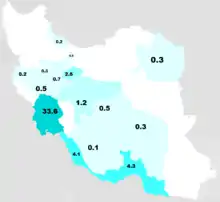Ahwazi Arabs
Ahwazi Arabs are an Arab community in Iran which resides mostly in the resource rich Khuzestan Province in southwestern Iran, bordering Iraq.[1] This area is known as Ahwaz by the Arab community, and the capital of Khuzestan is Ahvaz. Ahwazi Arabs are the largest Arab community residing in Iran.[2]
Population

According to Library of Congress, Iranian Arabs constitute 2% of the Iranian population.[3] The majority are Shia Muslims, while a minority, concentrated in the coastal areas, are Sunni Muslims.[4]
Discrimination allegations
According to Amnesty International, Ahwazi Arabs face discrimination by the authorities concerning politics, employment and cultural rights,[5] whereas Iran completely rejects such accusations, and considers such charges exaggerated.[6][7] There have also been many arrests of Ahwazi Arabs who have converted to Sunni Islam, which is considered a crime in Iran according to the British daily newspaper The Guardian.[8] Meanwhile, according to the Islamic Republic of Iran, there is no such crime or penalty in its law for converting to Sunni.[9][10]
The rise in conversion to Sunni Islam is partly a result of anti-Arab discrimination, the perceived crackdown on the Arab identity of the region and the view that Sunni Islam is closer to the Arab roots of the Ahwazi Arabs.[11][12] According to the International Campaign for Sunni Prisoners in Iran (ICSPI), the crackdown is due to the Iranian government's alarm at "the rise of Sunni Islam among the Ahwazi Arabs in the traditionally Shia-majority Khuzestan province."[13] As a result of these conversions, Sunni Arabs across the Middle East have increasingly shown support for the Ahwazi cause.[14]
References
- Mamoon Alabbasi (28 February 2015). "Iran's Ahwazi Arab minority: dissent against 'discrimination'". Middle East Eye. Retrieved 28 December 2015.
- "Iran: Defending Minority Rights: The Ahwazi Arabs". Amnesty International. 17 May 2006.
- Library of Congress, Federal Research Division. "Ethnic Groups and Languages of Iran" (PDF). Archived from the original on March 16, 2015. Retrieved December 2, 2009.CS1 maint: bot: original URL status unknown (link)
- James Minahan (2002). Encyclopedia of the Stateless Nations: A-C. Greenwood Publishing Group. pp. 158–9. ISBN 9780313321092.
- "Ahwazi-Arabern droht unfaires Verfahren und Folter". Amnesty International. Retrieved 2014-04-17.
- Ahvaz people yjc.ir Retrieved 26 June 2018
- Ahwaz cloob.com Retrieved 26 June 2018
- Peter Tatchell (27 October 2007). "Iran's anti-Arab racism". The Guardian. Retrieved 28 December 2015.
- Officialism of Shia demonstration farsnews.com Retrieved 266 June 2018
- Shia Mdhhab officialism khabarfarsi.com Retrieved 26 June 2018
- Mamoon Alabbasi (28 February 2015). "Iran's Ahwazi Arab minority: dissent against 'discrimination'". Middle East Eye. Retrieved 28 December 2015.
- ISABEL COLES (15 Aug 2013). "Insight: Iran's Arab minority drawn into Middle East unrest". Reuters. Retrieved 28 December 2015.
- Peter Tatchell (22 January 2015). "Sunni Muslims living in fear in Iran as state-sponsored persecution ramps up". International Business Times. Retrieved 28 December 2015.
- ISABEL COLES (15 Aug 2013). "Insight: Iran's Arab minority drawn into Middle East unrest". Reuters. Retrieved 28 December 2015.

